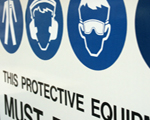Generally speaking, sound systems in industrial spaces are there to serve two purposes. One is to reproduce pages for people in the plant to hear. The second is to play background music for people to listen to. For years, it’s been about that simple. An amplifier, maybe a small mixer, and a few paging horns were all you needed. But the “rules” for industrial sound systems are changing, and the safety requirements are getting much more complex. How complex are these safety requirements? I’m glad you asked.
The answer is simple. The Life Safety Codes that cover evacuation systems for buildings are being updated. The National Fire Protection Agency (NFPA) publishes a new set of standards every few years. These codes cover everything dealing with fire safety, including electricity (NFPA 70) and fire alarms (NFPA 101). The 2010 version of the NFPA 101 includes new standards and guidelines for fire alarms and evacuation systems. Many types of spaces will be required to have a voice notification system in addition to the traditional horns and strobes that have been the standard for years.
The tricky part of a voice notification system is that in an emergency situation, people have to be able to not only hear an announcement, but they also must understand it. Or, in audio terms, it needs to be not only loud, but also intelligible. This means the system has to be well-designed using quality electronic components and loudspeakers. In many places, it won’t just be enough to put a few speakers on a wall and call it good. The space will need to be modeled so that the proper speakers and configuration can be designed and implemented. And, to top it off, the system will need to be monitored by the fire alarm system 24/7 to make sure it’s fully functional all the time. What started out as a simple little system for letting Bob know he has a phone call on line 1 has turned into a much more complex animal. And with that complexity also comes liability.
The industrial paging systems of today are used for life safety, so they have to work well, they have to work every time, and they have to meet code. The long and the short of all this is that if you’re constructing a new facility (or even making updates to an older one) there may be code implications for your paging system. If you get stuck in the codes and regulations, give us a call at Acoustics By Design. We’re here to make sure you’re covered in any emergency!
